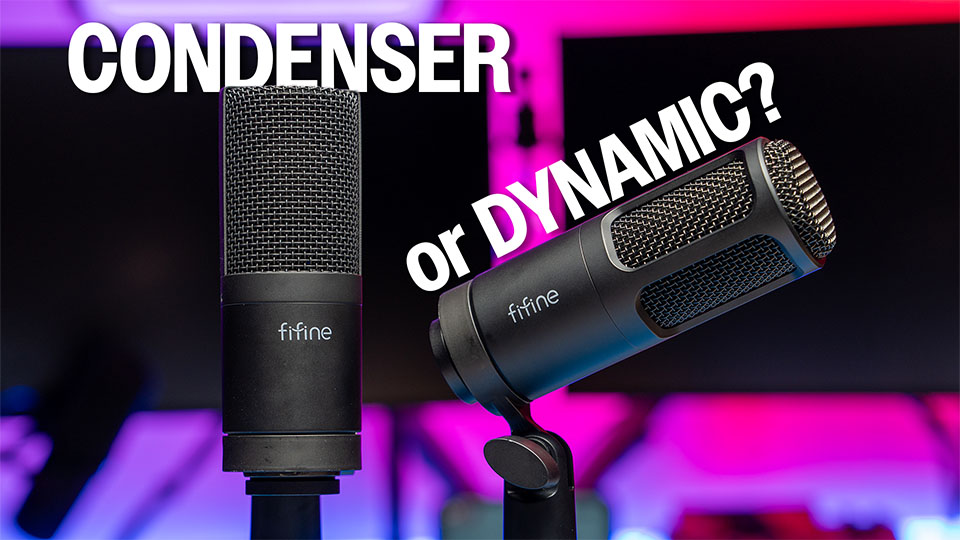Links in this post may be affiliate links. Any products purchased through affiliate links may provide a small commission which helps to support the SemiPro Tech+Gear site and YouTube channel.
When you’re starting out with content creation, you may wonder whether you should get a dynamic or condenser microphone. To help you decide, we take a look at the budget-friendly Fifine K669 D and C microphones in different recording environments.
The K669 line from Fifine offers quality metal construction and simple XLR output for the very accessible price of $37. The K669D is the dynamic option, and the K669C is the condenser option. Both offer build quality well above their price point – there are plenty of all-plastic microphones that cost upwards of $70-80 (some of Fifine’s own microphones included). The audio samples in the video embedded below are intended to offer some insight into how dynamic and condenser microphones behave in different recording environments.
Fifine K669D and K669C
MSRP: $37 (each)
Pros
- Metal build quality is great
- Sound quality is good for the price
- Different sound profiles make them a nice set for $74
Cons
- K669D picks up bumps/vibrations easily
- K669D is a bit harsh in the high frequencies
- K669C self noise may be a tad high
Best For: Content creation on a budget, or if you have to buy multiple mics for guests.
Features & Connectivity
K669D
- Dynamic capsule
- XLR output
- Metal body & mesh grille
- Plastic microphone stand mount with 3/8 and 5/8 threading
- -50dBV sensitivity
- 40Hz – 16kHz frequency response
- Max SPL 120dB
- Cardioid polar pattern
K669C
- 16mm condenser capsule
- XLR output
- Metal body & mesh grille
- Plastic microphone stand mount with 3/8 and 5/8 threading
- -43dBV sensitivity
- 30Hz – 20kHz frequency response
- 48v Phantom power required
- Max SPL
- Cardioid polar pattern
These are no-frills microphones, but that’s ok. Instead of putting the emphasis on multiple features such as USB connectivity, software DSP, and multiple physical buttons, Fifine put the emphasis on build quality with the K669 microphones. The mostly-metal build feels very solid and heavy, something uncommon for this price range.
The specs are respectable as well, with the sensitivity of the K669D being notable because -50dBV is actually fairly sensitive for a dynamic microphone. This means that you don’t need a high-powered preamp or interface in order to get a good signal level for recording or live broadcast, something that can’t be said for some dynamic microphones such as the famously-quiet SM7B which has a sensitivity of -59dBV.
Sound Quality
The sound quality of these microphones is very usable. That might not sound like shining praise, but at a price of $37, being usable or serviceable is actually the goal. The K669C provides a more natural sound profile, as condensers often do, with a less hyped high end but still a fair amount of detail. The K669D is likely a bit too boosted in the upper mids and treble frequencies for some, especially if you have a higher-pitched voice. It does, however, have a “broadcast” sound that is well suited for podcasting.
In general, condenser microphones are better suited for recording spaces that have a fair amount of sound treatment and no background noise sources. If your space is very quiet and has sound treatment (panels or sound blankets to absorb reflections, carpeted floor, covered windows, etc.), then condenser microphones could be a good fit and are worth considering. In spaces with a lot of background noise, condenser microphones will show their strength, which is picking up every detail around them (this is specific to medium and large diaphragm condenser microphones – shotgun microphones are designed differently).
Dynamic microphones are less sensitive and don’t require phantom power, and are generally better suited to recording environments that have some level of background noise (appliances, fans, etc.) or some reflections/echo. They won’t magically make those issues disappear, but because they are less sensitive overall, they tend to be worse at picking up detail of sounds that are far away from them (which in this case is good).
The type of content you’re making is also an important consideration. If your content will be talking-head style videos, you may want to also consider microphones that can be positioned off-screen and still focus in on the dialog without picking up too much ambient sound. There are several types of shotgun and small condenser microphones made for this purpose, including Rode’s VideoMic lineup which offer 3.5mm and USB outputs, and traditional XLR shotgun microphones.
Final Thoughts
Overall, if you’re looking for budget-friendly microphones to start your content creation or need to buy multiple microphones and want to keep cost down, I would recommend looking at the Fifine K669C and K669D. If your budget extends a little further, you may want to check out my recommended podcast microphones for suggestions at many price points.


